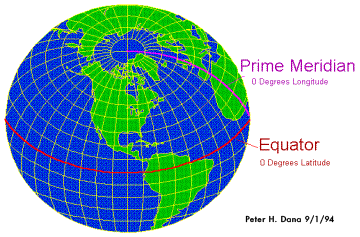2.2: Location and Time on Earth
- Page ID
- 2237
We define where we are on earth by several grid systems. The most common of these is latitude and longitude. Latitude and longitude divide the earth up into a series of parallel lines (latitude) and vertical lines running from the north pole to the south pole (longitude). Your book has a very good description of latitude and longitude, so read it carefully.
The base lines for measuring latitude and longitude are the equator and the prime meridian (see the graphic below).The equator goes around the middle of the earth, or it is the longest circumference. The prime meridian is an arbitrary line of longitude, but it was picked to go through Greenwich, England, the location of the Royal Observatory. Latitude is measured from 0 to 90 degrees north of the equator (0 to 90N), and 0 to 90 degrees south of the equator (0 to 90S), with 0 being the equator. It is easy to remember this by thinking about 180 degrees in a hemisphere, or half circle. Longitude is measured from 0 to 180 degrees east of the Prime Meridian (0 to 180E) and 0 to 180 west of the Prime Meridian (0 to 180W). Therefore, everything in the United States has a northerly latitude (it is in the northern hemisphere), and a westerly longitude (it is in the western hemisphere).

Increments of latitude and longitude are called ‘degrees’. One degree is divided into 60 minutes (‘). One minute is divided into 60 seconds (“). So a location might look something like this: 37º15’ 23”N, 122º14’8”W (where is this?).
Conduct some research about the relationship between time and longitude. Each 15º increment in longitude equals one hour of time on earth. We have roughly divide the earth up in this manner by time zones. You can therefore roughly estimate (ignoring daylight savings time and the peculiarities of political gerrymandering of time zones) how many hours earlier or later one location is from another. For example, if you were in a ship at 20ºW and you sailed to 80º W, what time would it be in your new location if it was 6pm in your old location? You would have traveled 60º to the west, so 60/15 = 4, and west equals earlier, so it would be 2pm in your new location.
Check out the web site World Clock for time by location on earth.


